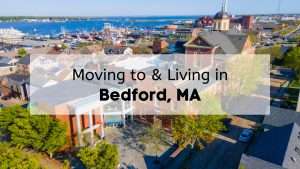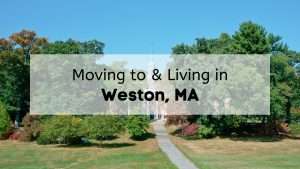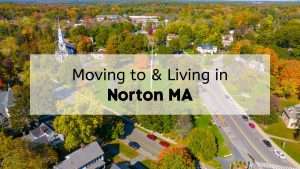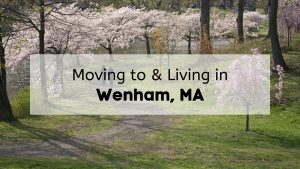Last Updated on: 25th March 2024, 08:44 am
Newton is one of the most charming suburbs of Boston, with all the convenience and amenities of modern life yet retaining its historic charm and small-town feel. Newton does not have a single city center or downtown area. Instead, it’s made up of thirteen villages, most of which have their own town center. Each village has its own unique history and appeal – you’re sure to find plenty to love about each one!
If you’re thinking about living in Newton or just visiting, exploring the 13 villages of Newton MA is a good place to start.
Table of Contents
Auburndale – Home to Lasell College & the Riverfront Auburndale Park
- Auburndale MA population: 6,900
- Zip code: 02466
- Median household income: $113,200
Bordered by the city of Waltham along the Charles River, Auburndale is home to the private Lasell College. The historic Auburndale village, founded in 1678, remained remote farmland and marsh until the mid-19th century when the Boston and Worcester Railroad connected Newton to Boston. The North Auburndale Land Company began developing Auburndale in 1847 as a suburban commuter town, laying out new residential streets north of the Auburn Street colonial highway. By the 1860s, Auburndale was thriving with many boat clubs along the river.
Located at the intersection of I-95 and I-90, Auburndale remains popular with commuters and families with easy transportation options. It’s served by the MBTA Commuter Rail from the Auburndale station and the MBTA Green Line from the Riverdale and Woodland stations. Auburndale is home to two golf courses – the private Woodland Golf Club and the Brae Burn Country Club – and Auburndale Park, a large riverfront park with the Cove playground and public ice skating on the river.
Chestnut Hill – Newton Village Home to Boston College & Shared with Boston and Brookline
- Chestnut Hill MA population: 8,000
- Zip code: 02467
- Median household income: $140,700
Chestnut Hill village is one of the most well-known of the 13 villages of Newton MA. Famously home to Boston College, Chestnut Hill is located in Newton, Boston, and Brookline and three counties: Norfolk, Suffolk, and Middlesex counties.
Much of the Chestnut Hill area was developed in 1870 by famed landscape architect Frederick Law Olmstead who also designed the Boston Emerald Necklace and NYC’s Central Park. The 120-acre Chestnut Hill Reservation was designed by Olmstead’s son in the 1860s to provide a rural park and drinking water for Boston.
Chestnut Hill is known for its historic mansions and estates with beautiful examples of Tudor Revival, Victorian, Colonial, and Italianate architecture. The village is served by three Green Line branches and is home to the Shops at Chestnut Hill and the Street at Chestnut Hill shopping centers.
Learn more about living in Chestnut Hill with our complete guide!
Newton Centre – Village with the Largest Downtown Newton District
- Newton Centre MA population: 1,700
- Zip code: 02459
- Median household income: $174,900
Newton Centre is one of the smallest Newton villages by population but home to the largest Newton downtown area. It’s the main destination for upscale shopping in the western Boston suburbs, with a commercial district surrounding Langley Rd, Centre St, and Beacon St along Newton Centre Green.
Along with shopping, Newton Centre is known for its many primary and higher education facilities, including the Boston College Law School, Hebrew College, the all-girls Mt. Alvernia High School, and the all-girls Newton Country Day School. The 33-acre natural Crystal Lake is also in Newton Centre with a designated swimming area.
Newton Corner – “Boston’s First Village” Bordering Brighton, Boston
- Newton Corner MA population: 5,800
- Zip code: 02458
- Median household income: $150,500
Like many Newton villages, Newton Corner was established in the 1600s and grew slowly until the railroad arrived in the mid-19th century. Increasing traffic along Washington Street to and from Boston and the western communities helped Newton Corner grow and become Boston’s first village.
The arrival of the railroad and then daily commuter trains helped Newton Corner prosper with the beginnings of a central business district and many shopkeepers and tradespeople. By the 1880s, it was a desirable community for white-collar Boston workers thanks to a large supply of homes for rent and the former large estates and farmlands were broken up into smaller lots.
The construction of the Massachusetts Turnpike Extension dramatically changed Newton Corner. Despite protests from the city of Newton, the turnpike was built, cutting Newton Corner in half, demolishing about one-third of its businesses and most of the central business district, disrupting its historic street patterns, and eliminating pedestrian traffic between the two halves of the village. The village still suffers from heavy traffic caused by the turnpike, but its prime location bordering Boston and Watertown and easy transportation make it popular with commuters.
Newton Highlands – Affluent & Family-Friendly Village in Newton
- Newton Highlands MA population: 8,800
- Zip code: 02461
- Median household income: $170,300
West Newton and Newton Corner were developed thanks to the construction of the Boston and Albany Railroad in the 1830s, but Newton Highlands wasn’t connected to the Boston area until the 1850s with the arrival of the Charles River Railroad. Because the railroad offered very infrequent commuter trains, it wasn’t until the 1870s that Newton Highlands experienced much growth with the completion of the Back Bay landfill project. It had more than 500 families by 1874 and became a desirable community for working class and upper class families who thought it was a rustic and healthy place to raise a family.
Newton Highlands remains a family-friendly place to live in Newton with a close-knit community, regular events like the Highlands Village Day festival, gorgeous Victorian homes, and a bustling village center.
Newton Lower Falls – Former Industrial Village and Now a Quiet Residential Suburb
- Newton Lower Falls MA population: 1,200
- Zip code: 02462
- Median household income: $146,200
Newton Lower Falls is the smallest Newton village by population. A dam was built here in 1704 to generate power for an ironworks, with other dams following. The village was home to six paper mills by 1816 and became a thriving industrial community until residential development halted as the papermaking industry faltered. Today, it’s mostly a residential suburb centered around the Lower Falls Community Center. It’s home to a fairly large commercial district that extends over the Charles River into Wellesley.
Newton Upper Falls – One of the Six Original Newton Villages
- Newton Upper Falls MA population: 7,500
- Zip code: 02464
- Median household income: $112,300
Newton Upper Falls village is one of the six original, founding villages of Newton. It’s the only one with its original name before Newton separated from Cambridge. In the 18th and 19th centuries, Newton Upper Falls was a major manufacturing center with many mills built on the river.
Today, the Upper Falls area is desirable for young professionals and families thanks to its central location bordering West Roxbury, Boston, Wellesley, Needham, and Oak Hill, with the Eliot Station providing light rail service into downtown Boston.
Newtonville – Quiet Residential Neighborhood in Newton
- Newtonville MA population: 11,200
- Zip code: 02456
- Median household income: $173,800
One of the most affluent Newton neighborhoods, Newtonville is also the largest village by population. This mostly residential community is split by the MBTA Commuter Rail and Massachusetts Turnpike, with shopping along Walnut Street and Washington Street. The village offers great transportation options, with Route 59 providing easy access to Watertown Square and the Newtownville station of the MBTA Commuter Rail. While it retains its historic charm, the village has many newer developments like Washington Place, which will have 140 residential units, ample parking, and retail space.
View this post on Instagram
A post shared by new england ramblings, always walking (@rickinmarblehead)
Nonantum – The Most Densely Populated Neighborhood in Newton MA
- Nonantum MA population: 9,600
- Zip code: 02495
- Median household income: $103,100
Once known as North Village, Nonantum spent the 17th and 18th centuries as farmland until the mid-19th century. Thanks to a pond at Adams and Nevada streets, it was later known as Silver Lake and is sometimes still referred to as “the Lake.” For over a century, Nonamtum was a prosperous center producing rope, woolen goods, and cotton.
The need for more mill workers prompted the construction of affordable housing, which led to an influx of immigrants between 1860 and 1910. The village eventually became known as Nonantum after the Nonantum Worsted Company which dominated the community in the 1880s.
By the early 20th century, most of the factors closed, and Silver Lake was filled in and developed. Nonantum village is still the most densely populated of the Newton villages and offers residents convenient shopping, river access, several parks, and easy access to I-90.
Oak Hill – Newton Neighborhood Built Entirely for WWII Veterans
- Oak Hill MA population: 7,000
- Zip code: 02459
- Median household income: $168,700
Oak Hill has a unique history as one of the youngest of the 13 villages of Newton MA. Many veterans returning from World War II encountered difficulty finding homes available to buy or rent, leading to many housing tracts being developed across the country. The City of Newton took a unique approach, building a brand-new neighborhood for its veterans with over 400 homes, a school, and shopping center.
Known as Oak Hill Park, the community was funded completely by the city without federal or state funds, with a new sewer and water main provided and lots sold at a tiny fraction of their value to the contractor. Many of the original homes still exist, although larger, newer homes are also found in the community. Today, Oak Hill Village is home to the Mount Ida Campus of UMass Amherst and the Charles River Country Club.
Thompsonville – Small, Residential Village Along Route 9
- Thompsonville MA population: 3,600
- Zip code: 02459
- Median household income: $119,900
Thompsonville gets its name from a hermit named Thompson, who lived in the heavily wooded area at the beginning of the 19th century. By 1867, Thompsonville was a small settlement with several families and a church. Unlike most Newton villages, Thompsonville does not have its own village center, and it has one of the smallest populations.
Waban – One of the Youngest Villages of Newton
- Waban MA population: 4,200
- Zip code: 02468
- Median household income: $161,600
Waban is one of the most recently developed Newton villages. It was largely farmland until the 1880s when the Boston and Albany Railroad reached the community and led to new development. Housing tracts were quickly developed, and daily commuter trains connected Waban to downtown Boston.
While it’s one of the furthest villages from Boston, Waban is a desirable community thanks to its location along the Charles River and bounded by Route 9 and I-95. It’s home to the Newton-Wellesley Hospital Main Campus, one of the major employers in Newton.
West Newton – One of the Oldest Villages with a Charming Town Center
- West Newton MA population: 9,300
- Zip code: 02465
- Median household income: $119,700
West Newton is one of the oldest villages in Newton and enjoyed rapid growth in the 19th and 20th centuries thanks to its location. Modern-day Washington Street connected Natick, Boston, and the western communities, with the village eventually becoming a Boston & Worcester Railroad station stop. Local workers and immigrants built modest homes in the village, but eventually, the community became known for its more extravagant homes with turrets, intricate trim, and Second Empire and Queen Anne architecture.
West Newton is home to the private all-boys Fessenden School and a large commercial district along Washington Street with the long-running West Newton Cinema.
Does life in one of these historic neighborhoods in Newton seem like just what you’re looking for? Let Mass Bay Movers help with your relocation for a seamless, stress-free moving day. Call our Newton movers today for a free, personalized moving quote.







